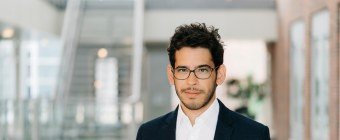New digital tool supports planning on water infrastructure investments
26.09.2019
To address the world's freshwater scarcity, COWI’s industrial PhD Raphaël Payet-Burin has developed an open-source model in partnership with the Technical University of Denmark and Massachusetts Institute of Technology (MIT). The framework is a step forward in solving complex water and agricultural challenges and well in line with COWI's digital and societal ambitions.
The newly developed tool called WHAT-IF works on an open-source platform without licensing requirements; adds a GIS interface for improved stakeholder dialogue; and allows additional complexities to be considered, including switching between "optimization" and "simulation" mode.
Peter Qwist-Hoffmann, Project Director in BL DK's Water and Environment division, considers the tool to be a very important contribution to the prevention of conflicts between countries as the competition for freshwater is escalating due to climate change, increasing population, and economic growth:
"The novelty of the tool is that it combines a hydro-economic optimization framework, with a nexus representation of the agriculture and food systems. The tool can represent political boundaries, the joint development of infrastructure and policies, and uncertainty in future climate and socio-technical changes," says Peter Qwist-Hoffmann.
WHAT-IF aims to provide quantitative answers to the following prototypical questions:
- What is the economic impact of a given set of projects? Which is the best alternative among different investment plans?
- What are the synergies or trade-offs between investments and/or policies in different sectors? In other words: What are the trade-offs between hydropower, irrigation development plans, and ecosystem preservation?
- What are the risks linked to uncertainty in future climate and socio-economic changes? Which investments and policies will be more robust to a range of future conditions?
Heated debate over a dam sparked interest in transboundary water challenges
The PhD student behind the tool, Raphaël Payet-Burin, got specially interested in the transboundary water resource problematic when, during a summer school in München, a workshop about a dam project in Ethiopia turned into a heated debate between Egyptians and Ethiopians.
" I could see that this would be a major challenge for society and a highly interesting topic to work on. I am highly motivated as this industrial PhD-project combines three of my personal interests with key societal challenges: the water-energy-food nexus, transboundary water resource management, and climate change," explains Raphaël Payet-Burin.
Silvio Pereira, Project Manager in the International Water Department, says:
"The tool was successfully applied in the development of a strategic plan for the Zambezi Watercourse. Since then, the tool has been further improved, the new version is even more flexible in addressing complex issues, and we will work on the further application of WHAT-IF in river basins throughout the world."
Water infrastructure development plans will help countries and regions realize the potential of their water resources. Ecosystem preservation, hydropower and irrigation development will contribute to multiple Sustainable Development Goals, including: End Poverty (SDG1), Zero Hunger (SDG2), Clean and available water for all (SDG6), Clean and affordable energy for all (SDG7) and Sustainable economic growth (SDG8). Some of these goals may result in conflicting objectives; WHAT-IF can assist decision makers in balancing them.
Background
COWI started the development of a hydro-economic model called Basin Economic Allocation Model (BEAM) about eight years ago in the Aral Sea (Central Asia) under a World Bank contract. The model was used to assess the economic impact of various water allocations within a Water-Energy-Food Nexus framework.
A second-generation model called "Water-Hydropower-Agriculture-Tool for Investments & Financing" (WHAT-IF) was developed two years ago under a contract with the OECD. WHAT-IF has been used on investment projects in Kazakhstan (Central Asia), as well as for the recently adopted Strategic Plan for the Zambezi Watercourse (Southern Africa), financed by the World Bank.
The development of WHAT-IF has also led to a scientific publication (https://www.hydrol-earth-syst-sci-discuss.net/hess-2019-167/) and a range of conference presentations, including the European Geoscience Union in Wien; the International Association for Hydro-Environment Engineering and Research in Panama; the World Congress of Environmental and Resource Economists in Göteborg; and the World Water Week in Stockholm.
FACT BOX
- The majority of the world's available freshwater resources are located in transboundary river basins or aquifers.
- Competition for the water between countries and between people is escalating with increasing population and wish for socio-economic growth and wellbeing.
- Comprehensive basin plans are still required for most river basins; in particular, analysis of water infrastructure development is highly needed to enhance the efficient use of water and to make it available for socio-economic development throughout the year.
- At the same time, the Water-Food-Energy Nexus is central to sustainable development.
- Demand in all three sectors is increasing, driven by a rising global population, rapid urbanization, changing diets, and economic growth.
- Agriculture is e.g. consuming about 70% of the world’s freshwater resources, and a significant amount of energy is used globally on food production and supply.
Sources: UN-Water https://www.unwater.org/water-facts/transboundary-waters/ and others.
Get in contact

Jesper Karup Pedersen
Technical Director
Economics and Management, Denmark
Tel:
+45 5121 1789
jkp@cowi.com
